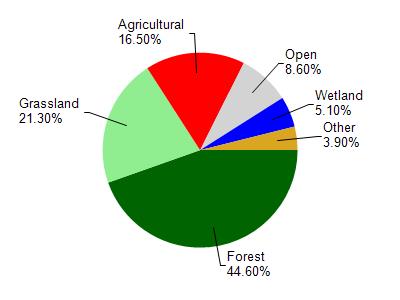Vernon
Yes
No
No
Fish and Aquatic Life
Overview
Hasley Creek, located in northwestern Vernon County, flows for approximately 1.5 miles in a northerly direction before reaching Coon Creek east of Chaseburg. It has a gradient of 57 feet per mile and drains steep forested hillsides and agricultural land in the valley. Numerous springs enter the stream at various locations. Hasley Creek is classified as a Class III trout stream for its entire length.
From: Koperski, Cindy. 2002. The State of the Bad Axe - La Crosse Basin. Wisconsin Department of Natural Resources, Madison, WI.
Date 2002
Author Cynthia Koperski
Historical Description
This clear, hard water stream flows in a northerly direction and joins Coon Creek about one mile east of Chaseburg. It is Class III brown trout water. Forage species such as common shiner and white sucker are present. The winter aerial groundwater survey found scattered open water areas throughout the stream. Sand is the primary bottom type. There is some silt, and a little gravel and rubble. There is navigab1e water access from Coon Creek. Wood ducks nest along the stream.
Hasley Creek, T14N, R6W, Section 27. Surface Acres = 1.8, Miles = 1.5, Gradient = 57.1 feet per mile.
From: Klick, Thomas A. and Threinen, C.W., 1973. Lake and Stream Classification Project. Surface Water Resources of Vernon County, Wisconsin Department of Natural Resources, Madison, WI.
Date 1973
Author Aquatic Biologist
General Condition
The most recent survey, completed in 1974, documented clear, cool water that carried a low suspended silt load. The streambed was composed of rubble, gravel, sand and a trace of silt. Bank cover consisted of willow, elm, box elder, and grasses. In-stream cover consisted of thick beds of watercress and veronica. A few deep holes were present but contained little cover. Brown trout were found during this survey along with a few minnow species. There is navigable water access from Coon Creek and a DNR easement borders Hasley Creek where it meets Coon Creek. The last stocking date for Hasley Creek was in 1975 when yearling brown trout were planted. Since the fish and habitat data are 25 years old, Hasley Creek should be re-surveyed.
Date 2011
Author Cynthia Koperski
Condition
Wisconsin has over 84,000 miles of streams, 15,000 lakes and milllions of acres of wetlands. Assessing the condition of this vast amount of water is challenging. The state's water monitoring program uses a media-based, cross-program approach to analyze water condition. An updated monitoring strategy (2015-2020) is now available. Compliance with Clean Water Act fishable, swimmable standards are located in the Executive Summary of Water Condition in 2018. See also the 'monitoring and projects' tab.
Reports
Recommendations
Monitor Fish Community
WDNR should conduct a fish and habitat survey of Hasley Creek to document existing conditions.
Management Goals
Wisconsin's Water Quality Standards provide qualitative and quantitative goals for waters that are protective of Fishable, Swimmable conditions [Learn more]. Waters that do not meet water quality standards are considered impaired and restoration actions are planned and carried out until the water is once again fishable and swimmable
Management goals can include creation or implementation of a Total Maximum Daily Load analysis, a Nine Key Element Plan, or other restoration work, education and outreach and more. If specific recommendations exist for this water, they will be displayed below online.
Monitoring
Monitoring the condition of a river, stream, or lake includes gathering physical, chemical, biological, and habitat data. Comprehensive studies often gather all these parameters in great detail, while lighter assessment events will involve sampling physical, chemical and biological data such as macroinvertebrates. Aquatic macroinvertebrates and fish communities integrate watershed or catchment condition, providing great insight into overall ecosystem health. Chemical and habitat parameters tell researchers more about human induced problems including contaminated runoff, point source dischargers, or habitat issues that foster or limit the potential of aquatic communities to thrive in a given area. Wisconsin's Water Monitoring Strategy was recenty updated.
Grants and Management Projects
Monitoring Projects
| WBIC | Official Waterbody Name | Station ID | Station Name | Earliest Fieldwork Date | Latest Fieldwork Date | View Station | View Data |
|---|
| 1645200 | Hasley Creek | 10035010 | Hasley Cree - CTH KK | 1/1/2015 | 1/1/2015 | Map | Data |
| 1645200 | Hasley Creek | 10035009 | Hasley Creek - Shea property along CTH KK | 1/1/2015 | 1/1/2015 | Map | Data |
|

Watershed Characteristics
Hasley Creek is located in the Coon Creek watershed which is 238.20 mi². Land use in the watershed is primarily forest (44.60%), grassland (21.30%) and a mix of agricultural (16.50%) and other uses (17.60%). This watershed has 574.90 stream miles, 4,342.05 lake acres and 6,052.31 wetland acres.
Nonpoint Source Characteristics
This watershed is ranked High for runoff impacts on streams, Not Ranked for runoff impacts on lakes and Medium for runoff impacts on groundwater and therefore has an overall rank of Medium. This value can be used in ranking the watershed or individual waterbodies for grant funding under state and county programs.However, all waters are affected by diffuse pollutant sources regardless of initial water quality. Applications for specific runoff projects under state or county grant programs may be pursued. For more information, go to surface water program grants.